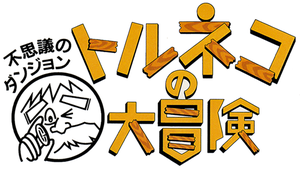Torneko no Daibōken: Fushigi no Dungeon: Difference between revisions
m (→Gameplay) |
m (→Gameplay) |
||
| Line 22: | Line 22: | ||
==Gameplay== | ==Gameplay== | ||
The gameplay is similar to [[Wikipedia:roguelike|roguelike]] style PC games. The main similarity is the heavy use of randomized dungeons and effects, with each square or panel representing one "step". While Torneko explores the dungeon, he collects items and fights monsters, similar to the ones found in ''Dragon Quest'' games. With every step the player takes, monsters will advance steps, too. If Torneko leaves the dungeon, he can sell off the items he found. He can also equip certain items found in the dungeon. By saving up money, Torneko can improve his home and shop. | The gameplay is similar to [[Wikipedia:roguelike|roguelike]] style PC games. The main similarity is the heavy use of randomized dungeons and effects, with each square or panel representing one "step". While Torneko explores the dungeon, he collects items and fights monsters, similar to the ones found in ''Dragon Quest'' games. With every step the player takes, monsters will advance steps, too. If Torneko leaves the dungeon, he can sell off the items he found. He can also equip certain items found in the dungeon. By saving up money, Torneko can improve his home and shop. The catch is that if Torneko falls in battle, all of his money and items are lost. | ||
==Music== | ==Music== | ||
Revision as of 12:55, 1 September 2016
| Mystery dungeon series | |
|---|---|
| Torneko no Daibouken: Fushigi no Dungeon | |

| |
| Developer(s) | Chunsoft |
| Publisher(s) | Chunsoft |
| Composer(s) | Kōichi Sugiyama |
| Series | Mystery Dungeon Dragon Quest |
| Platform(s) | Super Famicom |
| Release date(s) | JP September 19, 1993 |
| Genre(s) | Console role-playing game, roguelike |
| Mode(s) | Single-player |
| Media | 16-megabit SFC cartridge |
Torneko no Daibōken: Fushigi no Dungeon (Japanese: 不思議のダンジョン トルネコの大冒険) (loose translation: Torneko's Great Adventure: Mysterious Dungeon) is the first game in the Mysterious Dungeon series. This installment features Torneko (or Taloon, as he was known in North America), the merchant from Dragon Warrior IV. The game involves Torneko adventuring around in the "Mysterious Dungeon" in search of items.
Gameplay
The gameplay is similar to roguelike style PC games. The main similarity is the heavy use of randomized dungeons and effects, with each square or panel representing one "step". While Torneko explores the dungeon, he collects items and fights monsters, similar to the ones found in Dragon Quest games. With every step the player takes, monsters will advance steps, too. If Torneko leaves the dungeon, he can sell off the items he found. He can also equip certain items found in the dungeon. By saving up money, Torneko can improve his home and shop. The catch is that if Torneko falls in battle, all of his money and items are lost.
Music
As with other games in the Dragon Quest series, the musical score for the game was composed by Kōichi Sugiyama. Sony Records released the soundtrack, titled Suite Torneko's Great Adventure: Musical Chemistry, on October 21, 1993 in Japan. It contains eight arranged tracks performed by a chamber orchestra, as well as three tracks containing original game music.
Reception
In 2006, the game was voted number 78 by the readers of Famitsu magazine in its top 100 games of all time.
Gallery







